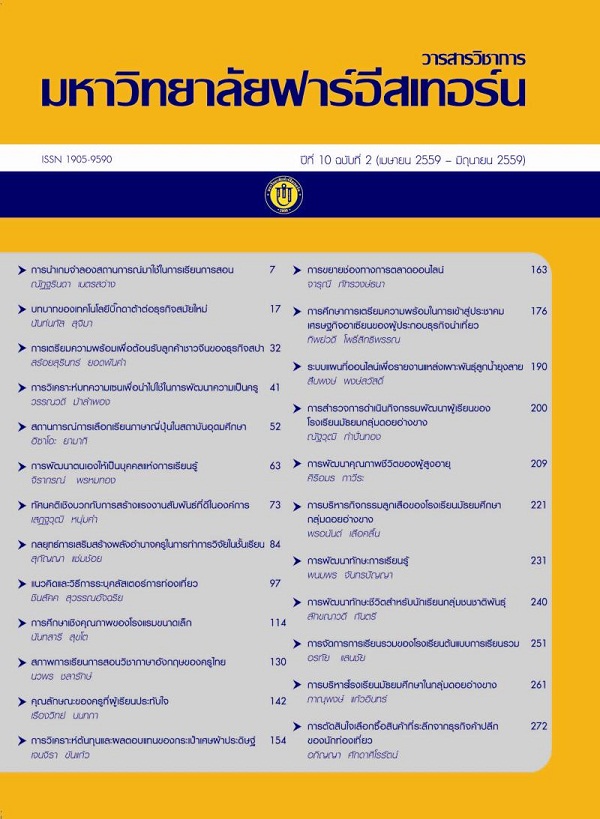การบริหารโรงเรียนมัธยมศึกษาในกลุ่มดอยอ่างขาง สำนักงานเขตพื้นที่การศึกษามัธยมศึกษา เขต 34 ตามกรอบการปฏิรูปการศึกษาในทศวรรษที่สอง
Main Article Content
Abstract
รวมจำนวนทั้งสิ้น 165 คน ปีการศึกษา 2558 เครื่องมือที่ใช้ในการวิจัย คือ (1) แบบสอบถามมาตราส่วนประมาณค่า 5 ระดับ มีค่าความเชื่อมั่นเท่ากับ .905 วิเคราะห์ข้อมูลโดยใช้ความถี่ ร้อยละ ค่าเฉลี่ยและ
ส่วนเบี่ยงเบนมาตรฐาน และ (2) การสัมภาษณ์ วิเคราะห์ข้อมูลโดยการวิเคราะห์เนื้อหา ผลการวิจัย
พบว่าการบริหารสถานศึกษาตามกรอบการปฏิรูปการศึกษาในทศวรรษที่สองของโรงเรียนมัธยม
กลุ่มดอยอ่างขาง สำนักงานเขตพื้นที่การศึกษามัธยมศึกษาเขต 34 โดยรวมและรายด้าน ผู้ตอบแบบสอบถาม
มีความคิดเห็นว่า มีการดำเนินงานอยู่ในระดับมาก โดยมีรายละเอียดเพิ่มเติมจากการสัมภาษณ์ ดังนี้
(1) ด้านกระจายอำนาจการบริหารและการจัดการศึกษาให้สถานศึกษาในเขตพื้นที่การศึกษา พบว่า สถานศึกษายังคงยึดหลักการกระจายอำนาจโครงสร้างการบริหารงาน 4 ฝ่าย ได้แก่ ฝ่ายงานบริหาร
งานวิชาการ ฝ่ายงานบริหารงานบุคคล ฝ่ายงานบริหารงานทั่วไป และฝ่ายงานบริหารงานงบประมาณ ซึ่ง
อาจมีการปรับเปลี่ยนโครงสร้างตามความเหมาะสมกับสภาพบริบท โดยมีการเน้นทางด้านงานวิชาการเป็นหลักและมีการดำเนินการเป็นนิติบุคคลมากขึ้น (2) ด้านพัฒนาระบบบริหารจัดการตามหลักธรรมาภิบาลให้มีความโปร่งใสเป็นธรรม และมีระบบการตรวจสอบที่มีประสิทธิภาพ พบว่า หลักธรรมาภิบาลช่วยบรรเทาความขัดแย้งภายในสถานศึกษา มีการจัดระบบที่มีความโปร่งใสชัดเจนมากขึ้นโดยมีการนำหลักสถิติมาใช้ประกอบในการพิจารณาตัดสินใจ (3) ด้านพัฒนาการบริหารจัดการเพื่อเพิ่มโอกาสทางการศึกษาอย่าง
มีคุณภาพ พบว่า สถานศึกษาควรมีการสร้างแหล่งเรียนรู้เกี่ยวกับสายอาชีพหรือทวิศึกษาที่เหมาะสมกับบริบทผู้เรียน เพื่อลดปัญหาเด็กด้อยโอกาส แนะแนวทางการประกอบอาชีพสร้างรายได้และลดปัญหาการออกกลางคันของผู้เรียน (4) ด้านพัฒนาระบบบริหารจัดการเพื่อส่งเสริมสนับสนุนการมีส่วนร่วมของประชาชน ภาคเอกชนและทุกภาคส่วนในการจัดการศึกษาและสนับสนุนการศึกษาและเรียนรู้มากขึ้น พบว่า ผู้บริหารควรแสดงบทบาทการเป็นผู้นำในการเข้าหาองค์กร และหน่วยงานทุกภาคส่วนที่มีส่วนเกี่ยวข้องกับการจัดการศึกษา และนโยบายลดเวลาเรียน เพิ่มเวลารู้ เป็นการกำหนดบทบาทให้หน่วยงาน องค์กรท้องถิ่น ภาครัฐและเอกชนเข้ามามีส่วนร่วมในการจัดการศึกษา (5) ด้านพัฒนาระบบบริหารจัดการทรัพยากรเพื่อการศึกษาให้มีประสิทธิภาพ พบว่า สถานศึกษาบริหารทรัพยากรของสถานศึกษาใช้หลัก 4M’s โดยดำเนินการตามกฎ ระเบียบการเงินและพัสดุ มีการกำกับ ติดตามโดยหน่วยงานต้นสังกัด
This research aimed to study the school administration based on the second decade education reform guidelines of Doi Ang Khang cluster secondary schools attached to the Secondary Education Service Area Office 34. The sample used in this study included 17 school administrators and 148 teachers. There were totally 165 people in the academic year 2015. The tools used in this research comprised (1) 5-rating scaled and Reliability have .905. Questionnaires analyzed by frequency, percentage, mean and standard deviation and (2) interviews analyzed by content analysis. The study found that: according to the school administration based on the education reform in the second decade guidelines of Doi Ang Khang cluster secondary schools attached to the Secondary Education Service Area Office 34 as the whole picture and each aspect, the respondents agreed that the performance was at high level as the following details. (1) Regarding the decentralized management and education administration for the schools in the education service area, it revealed that the schools still maintained the principle of decentralized management structure with 4 divisions, such as academic affairs administration, personnel management, general administration and budget administration which may be adjusted according to the appropriateness with the context by emphasizing the academic affairs mainly and operating as a corporation a lot more. (2) Related to the management system development based on the principle of good governance with transparency, fairness and an effective monitoring system, it was found that the principle of good governance alleviated the conflicts within the schools with more transparent and clearer system management by using the principle of statistics for making a decision. (3) Related to the management development to enhance education qualitatively, it indicated that the schools should create learning sources about career study fields or dual education being suitable for learners to reduce disadvantaged children’s problems, guide them how to do a career, generate incomes and reduce the students’ dropout problems. (4) According to the management system development to promote the participation of people, private sectors and all sectors in educational management and support much more education and learning more, it was found that the administrators should perform leadership their duties by contacting organizations, agencies and all sectors involving in educational management, the policy of reducing classroom hours and increasing learning time. That assigned the roles for agencies, local organizations, public and private sectors to participate in the educational management. (5) According to the resource management system development for efficient education, it revealed that the schools managed their resources based on the principle of 4M’s by following financial and procurement rules and regulations and were monitored by the agencies.
Article Details
1. Any views and comments in the Journal of Social Innovation and Lifelong Learning are the authors’ views. The editorial staff have not to agree with those views and it is not considered as the editorial’s responsibility.
2. The responsibility of content and draft check of each article belongs to each author. In case, there is any lawsuit about copyright infringement. It is considered as the authors’ sole responsibility.
3. The article copyright belonging to the authors and The Far Eastern University are copyrighted legally. Republication must be received direct permission from the authors and The Far Eastern University in written form.

